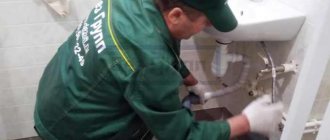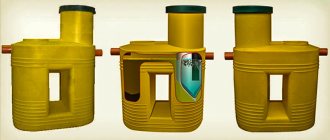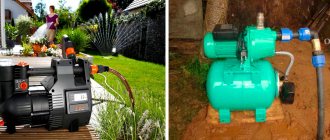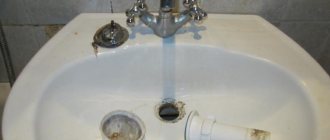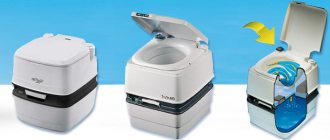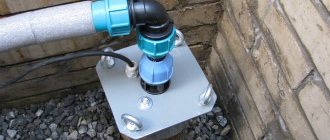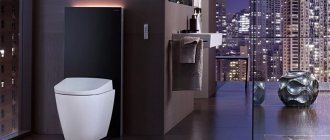Criterias of choice
A set of assessments will help you understand how to understand the need to choose a specific model in a particular case:
- the diameter of the inlet hole with the grill is determined;
- the method of installing the cabin tray is being clarified, since it affects the installation height of the siphon;
- the throughput and operational features of each model are specified; you need to know the quality of the material; possible problems with model installation.
The choice of one model for a particular case is made after weighing the pros and cons.
Model size or appearance
- It is known that the installation height of the siphon directly depends on the installation method of the cabin bowl structure. When it is installed on a raised platform, you can choose a siphon with a height in the range of 8-20 cm. If the bottom of the cabin is mounted on the floor and blown in with foam, then the choice is limited. The main thing is to focus on a quality product. After all, replacing it will require a lot of effort.
- The diameter of the inlet hole with the grate is selected so that it coincides with the hole in the bowl. Attention is paid to the quality of parts and their integrity, since a small crack will lead to leakage. The known diameters are: 52 mm, 62 mm, 90 mm.
Technical characteristics indicators
The drainage system is selected in tandem with the mixer. Their technical characteristics are the performance of the mixer and the throughput of the siphon. This will help avoid rapid flooding of the pan and timely release of liquid into the sewer.
The smallest throughput according to GOST 23289-94: for low cabin bowls - from 15 l/min; for bowls with a high side and a siphon with overflow - from 21 l/min.
The throughput is calculated in accordance with the height of the cabin bowl and the diameter of the siphon outlet hole. Technical indicators are reflected in numbers: diameter is 5.2 and 6.2 cm, - liquid is collected in the pan up to 12 cm; indicator 9 cm diameter - liquid will be about 15 cm.
Features of siphon operation
- The main condition for installation is the tightness of all connections, but everything is done in such a way that in the event of a breakdown, it can be disassembled manually without effort. We must not forget about emergency situations; there is no time to waste, otherwise there will be a flood in the room. In the best case, the problem will be in your own apartment, in the worst case, the water will leak to the neighbors below. Then you will have to pay them for repairs.
Step-by-step instructions for installing a drain siphon
Before starting work, you should prepare the optimal equipment connection points, taking into account the location of existing sewer systems. Sometimes it is necessary to redo the central riser and provide for the introduction of a drain pipe with outlets in specific places.
A pipe has been laid in advance to the installation site of the shower tray.
Note! If you haven't laid sewer pipes yet, use our slope calculator with detailed explanations.
Manufacturers of linear drains claim that their design allows a large volume of water to pass through by increasing the linear dimensions of the receiver. This is a publicity stunt.
The fact is that the throughput of the drains does not depend on the size of the external receivers, but on the diameter of the pipe. And they are standard for all systems, which means that the technical parameters are also almost the same. It does not matter which drain body is connected to the outlet with a diameter of 52 mm: drain, siphon or elbow.
Step 1. Before installing the ladder, check its technical condition. Remove the decorative cover and carefully inspect the contents. The most modern models are quite complex devices from an engineering point of view; each node and element performs its own tasks.
- Water seal. The operating principle is no different from an ordinary cylindrical siphon water valve. There are features of the shape: it is not round, but oblong. This is explained by the linear shape of the ladder.
- Dry shutter. Two plastic balls are installed in the water seal; if the water in the sump has disappeared, they drop down and block the outlet holes. Under normal conditions, the balls float on water in a water seal; they have a lower density. In this way, it is possible to obtain double protection against the entry of unpleasant odors from the sewer system into the room.
Drain with a dry seal
The cost of a complex drain with double protection is much higher than usual, and the actual operating parameters are somewhat lower. Why? Floating balls additionally limit the already small clearance of water drainage. The manufacturer claims that dry valves are needed in order to perform its function in the event of water evaporation from the water seal. But the fact is that the water from there will evaporate for years - in a limited space there is almost no air movement. Experienced plumbers in practice have not yet encountered a situation where, after several months of absence of the owners, odors appeared in the bathrooms; during this time, the siphon almost did not reduce the water level.
Step 2. Decide on the location of the drain.
Location determination
In our case, the shower tray will be finished with mosaic tiles, which makes the marking process a little easier. Using a tape measure, measure the distance from the water receiver to the wall and sides of the shower stall.
Measurements
Step 3: Adjust the receiver height. Some drain models have adjustable legs; adjust the length until the outlet aligns with the sewer pipe.
Gangway fasteners
Gangway legs
At the same time, constantly check the horizontal plane of the device.
It is important to install the ladder strictly horizontally
There are cases where existing sewer systems are located in such a way that the factory adjustment is not sufficient for proper installation. With plastic ladders the problem is solved quite simply. Sections of plastic water pipes of appropriate length are screwed to the leg supports with self-tapping screws. The ladder is raised to its original state, and then fine adjustments are made in the usual way.
Installed ladder
Step 4. Check the position of the drain again, if everything is normal, then you can start filling the pan.
Formwork
Filling the pallet
Leveling screed
Next, the shower cabin is installed and finished.
Installing a glass shower enclosure
Assembling a shower stall is relatively easy. It is enough to choose the appropriate cabin model in advance, prepare all the necessary tools, carefully read the instructions and perform the work carefully. On our website you will find not only recommendations for choosing shower cabins, but also installation procedures. Check it out in the article at the link to see if you can install it yourself.
Types of siphon for shower tray
The classification is carried out according to criteria: by the method of influencing the operation of the siphon and by its appearance.
According to the control method, three types are known:
- The first type is called the budget option. All inexpensive cabins are equipped with it. The design is regulated by a simple plug. The dirty liquid flows into the drain hole and enters the sewer system.
- The name of the second type is automatic. This type is recommended to be mounted on a high cabin bowl with an overflow hole. There is a lever that allows you to control the opening and closing of the plug without contacting it. To do this, the lever rotates in different directions. Full automation is far from complete and the name is conditional.
- Click-clack siphon for a shower tray belongs to the third type. It can be mounted on any pallet height and is considered universal. The design feature of the product: the drain plug opens and closes from the impact of the big toe on the plug itself. When you press the plug the first time, it closes, and when you repeat the actions, it opens. This type is more suitable under the name “automatic”.
According to its structural form, ease of installation and operation, the drain is presented in three types:
- Tubular model. All components appear in the form of curved tubes. Bending for the product is required. A water plug forms in this place. It saves you from unpleasant sewer odors. The design is rigid, which indicates its reliability. Installation work requires precision and accuracy. The compact siphon has different modifications. This allows it to be mounted under the lowest bowls. The interior walls are smooth and do not allow debris to accumulate on them. No need for frequent cleaning.
- Standard siphon or bottle siphon. It is suitable for high or low mounted cabins. The main difference is simple maintenance. Outwardly associated with a flask. There are two exits. A drain with a grate from the pan is connected to one. The second is a sewer system pipe. Cleaning is carried out after unscrewing the flask. Afterwards, rinse thoroughly. It is necessary to provide access from below. A bottle siphon for a shower stall with a low tray is therefore not advisable. The disadvantage of the installation is the difficulty in changing the direction of the outlet pipe. Its position changes if the drain neck in the pan hole is rotated.
- The siphon device for the shower cabin is corrugated. It is considered an economy option. A positive aspect of use is the ease of installation. The required form is manually specified. Recommended for installation under a low cabin bowl, the siphon is considered universal. The disadvantage is its short service life. Often bursts at bending points. Thin walls add flexibility to the model. Dirt quickly collects on uneven walls and requires frequent cleaning.
Types of drains
The industry produces a huge number of models of shower cabins; depending on the design features, a specific drainage system is selected.
| Drain type | Description of performance characteristics |
| The most common system, a water seal, reliably protects rooms from the penetration of unpleasant odors and does not create much resistance to water flow. This is very important for showers; they have low sides of the tray, which causes low pressure. In addition, the bottle siphon can trap various contaminants, which prevents serious contamination of the sewer system. The disadvantage is that there are many connecting parts, which increases the risk of leaks in sealing areas. Another problem is that the relatively large height limits the scope of application. |
| The function of the water seal and sump is performed by bending the pipe. It can be made from either ordinary smooth plastic or corrugated pipe. It has the simplest design, easy to connect. Disadvantages: difficulties with cleaning during inspection, rather high resistance to water flow. Corrugated siphons make installation and maintenance much easier, but they have an individual problem. All contaminants are retained on uneven surfaces; such devices must be cleaned frequently to restore their original capacity. |
| The most modern plums have a complex design. A siphon is placed inside the body; the principle of operation can be wet, dry or combined. Installation of drains eliminates stagnation of water; it is evenly and quickly removed from the entire surface of the shower tray. In terms of cost, plums are the most expensive. |
Additionally, all devices can be point or linear. Point ones have small water receivers. The dimensions of linear ones are limited only by the width of the pallet.
Channel water collection system
Practical tips for choosing a drain model
- Decide on the diameters of the pipes. According to European standards, there are three options: Ø52 mm, Ø62 mm and Ø90 mm. It should be borne in mind that drains with Ø52 mm and Ø62 mm require periodic cleaning. Accordingly, they must be placed in accessible places and the possibility of conducting an audit of the technical condition must be provided. A drain with a diameter of 90 mm is cleaned from the inside after dismantling the upper elements; it is not accessible from the bottom of the shower stall.
- The presence of a drain valve. Previously, an ordinary removable rubber or plastic plug was used for these purposes. To improve the comfort of using the cabin, engineers have developed an automatic and semi-automatic design. If you choose a drain with an automatic valve, you will have to install a drive system, and this requires preparatory work. Much less complexity with a click-clack valve; it opens/closes by pressing your foot.
Click-clack valve for shower tray
Innovation in creating new models
The dry siphon is a kind of technological advancement in the world of plumbing. It works when the height of the shower stall drain is very small. Now it will not be a water plug that will protect against the unpleasant “odors” of the sewer system, but a silicone membrane.
The liquid goes straight to the drain without delay. The silicone membrane works as a drain valve for the shower stall. Liquid is passed in a given direction, but sewer “odors” from the drain are retained.
The rolled up polymer tube is the membrane structure. When liquid passes through, it unfolds. When the flow stops, the membrane returns to its original form.
The membrane does not deform from cold or lack of moisture, which means that odors from the sewer are excluded. For example, the water seal often evaporates due to the operation of the “warm floor” system. The appearance of an odor in the room is due to the drying out of the water seal. Nothing will happen to a silicone membrane even in such a situation. And, conversely, in a room where it is rarely heated, installing a model with a membrane will allow you to forget about preserving it in winter. Others will burst at low temperatures due to the liquid remaining in them.
The disadvantage is the high price of the modern model and the repair of the membrane if it breaks.
Existing structures
From antiquity a design came to us in which the water of two communicating vessels equalizes its levels in height. Such vessels can be structurally obtained by bending a section of pipe, turning it with the fold down. The water collected in the bend, blocking the passage of air, becomes a water lock, and both ends of the pipe become vessels.
Bottle
Communicating vessels do not necessarily have to be located nearby. One of the vessels can be placed inside the other. This is the design used in bottle-type water seals. This is a flask (bottle) that has an outlet pipe and an inlet neck pipe, the edges of which are below the pipe tray. The water surface level is determined by the height of the outlet pipe tray. There is a design where a water lock is formed by using two communicating chambers separated by a partition.
Of course, in a water seal whose height is too limited, the height of the water lock is small. If the shower remains unused for a long time, the water in the water seal evaporates and air from the sewer leaks into the room. The situation can be easily corrected by pouring a little water into the shower sink to fill the water seal.
Pipe
This design is represented by a pipe bent in the shape of a U or S letter. A castle of water is formed at the bend of the pipe. The shutter product is most often made from plastic. Available in any height, low-height modifications are suitable for low shower trays. Debris is not retained by the smooth inner surface, so frequent cleaning is not required. Durable.
There is a modification of the pipe seal, where the pipe is corrugated and bent to form a water lock. It lacks the advantage of the main pipe water seal, such as low contamination, but can be easily installed and reach the sewer hole where it is inconvenient. Modification of such breech products is short-lived.
Dry
Where people do not live permanently, a dry shutter comes to the rescue - a relatively new type of locking product. Water flows directly into the drain without delay. Instead of a water lock, a silicone membrane is used. It is made in the form of a polymer tube, which, under the pressure of water, expands and allows a flow to pass through, and without water it returns to its original position. The pipe works in one direction, preventing water from returning to the plumbing fixtures. This is a lifesaver in cases of clogged pipelines, when water on the lower floors of the building, due to blockages in the riser, enters the devices in the bathrooms.
This shutter device has many advantages:
- Reliable operation, no need for regular checks,
- It does without water, so it doesn’t freeze,
- Made of anti-corrosion material,
- Easy to install and can be installed both horizontally and vertically,
- Doesn't make noise when working
- Does not form stagnant water,
- Long lasting,
- Resistant to blockages.
The disadvantage is the high cost.
Three main types have been developed, differing in design, size and purpose.
For showers with a low sink position, drains are also used.
For shower trays with overflow
In deep trays, it is often possible to install siphons with overflow. An overflow is an additional device made from a pipe that is connected to the drain hole (at the top of the sink wall) and to the valve. The top hole in the shower sink has a diameter of 4 cm, so the overflow pipe also has a smaller diameter.
The pipe is made flexible, corrugated is used, since shower sinks can have different sizes and their drain holes can be located either in the center of the bottom or on the side. Therefore, the distances from the overflow hole to the drain hole vary for different modifications of cabins. The shutter must be suitable for a variety of types of pallets.
Modifications of valve products with overflow are designed for all types of siphons.
Designs based on the type of drain locking
Developers of plumbing fixtures have come up with several devices to retain water in the cavity of the sink of a plumbing fixture. So, in addition to the usual closing of the drain using a stopper, the drain can be closed using a lever or by pressing a button. Everyone knows the cork option. Two other plums are of interest.
In one case, the bottom release valve closes automatically by turning the lever. The lever is located next to the mixer so that it is at hand. When turning the valve, the valve closes partially or completely. The fact that the mixer and valve are sold together, and they also need to be installed together, is not entirely convenient.
The second device received the sonorous name Click-clack (sometimes you can find the name Push&Open). This is a push-button valve with a mechanical latch and is operated by foot. The first time the button is pressed, the valve closes; the second time, it opens. The valve is easy to install and user friendly.
Choosing a siphon for a tray with overflow
An additional tube that connects the siphon itself and the tray overflow and distinguishes the shower overflow drain from other models. If this does not happen, then if there is an excessive amount of liquid in the pan, a flood will occur and it will spill out onto the floor.
Overflow is found in high pallet designs. They are used for bathing small children instead of a bath. Enterprising housewives do laundry in it.
The diameter of the overflow hole is about 4 cm. The corrugated pipe is the hose connecting it to the siphon. Due to the corrugated hose, the siphon is mounted on a tray with different overflow locations. Suitable for any pallet model.
Manufacturers
The most popular and in demand metal-plastic models of shower siphons from domestic and foreign manufacturers:
- multi-position model WIRQUIN BOND JAMES in black from the French manufacturer Wirquin. It is distinguished by the presence of a self-centering gasket and a compact removable filter;
- model WIRQUIN Tourbillon gray from the French manufacturer Wirquin. Characterized by an ABS chrome grille and an easy to clean removable cup;
- domestic model UNICORN for deep trays with chrome-plated overflow, flexible outlet to the sewer system and a cup made of stainless steel;
- the Temporlekh Plus model from the German manufacturer Viega, which has a convenient horizontal outlet, a chrome plate and high throughput;
- the Raindrain model from the German manufacturer Hansgrohe, characterized by high productivity (51 l/min), for a water level of 150 mm and the presence of an external steel panel;
- German model Ideal Standard, characterized by a drain hole diameter of 9.0 cm and good throughput;
- Uniflex model from the Swiss manufacturer Geberit, which has the ability to dismantle the immersion pipe and its retainer, an installation height of 8.0 cm, and mobility of the outlet pipe within 15°.
Siphon for shower cabin IDO SHOWERAMA
Manufacturers produce shower siphons of horizontal and vertical types. The first option is used when the height of the shower tray is small or completely absent. In this case, the wastewater flow is directed to the side, which minimizes the size of the device.
Vertical or direct-flow siphons are characterized by water draining downward, thereby increasing the throughput of the system.
Rules for preventive cleaning of siphons
The shower tray siphon will last longer if it is cleaned once every 6 months for preventive maintenance. Household chemicals designed for working with plastic are used.
- If a blockage occurs, it is not recommended to use metal objects for cleaning. The corrugation can easily break through.
- Cleaning by blowing compressed air under pressure will lead to depressurization of the entire system. The joints are weak points. They need to be protected. After all, the drainage system is assembled from several parts. Under pressure, the structure may rupture.
What does a siphon consist of?
The standard design of the device includes the following parts:
- upper grille with seal;
- waste baskets with a compactor;
- outlet for water drainage with a recess for the upper seal;
- gaskets for the outlet pipe;
- a screw that is screwed into the pipe nut;
- water seal devices.
When purchasing a shower cabin, it is better to use the original equipment included with the tray. This way you can protect yourself from depressurization of the sewer drain.
If there is no such device, then it is better to buy ladders from reliable companies that are made of high-quality plastic or chrome-plated metal. If possible, you should avoid low-quality plastic Chinese ladders, which have a limited shelf life.
How to clean siphons?
It is worth taking care of cleaning the knee in advance, at the stage of installation of the structure during repairs. For this purpose, the siphon is equipped with a special inspection hole, which will perform not only the function of overflowing water, but also the function of cleansing dirt.
Such a hole is needed only for narrow devices, while a nine-centimeter drain is cleaned directly.
If the device is installed in a tray with a low height, then in this case additional devices are used to retain hair, as well as a special self-cleaning design.
You can also clean particularly heavy stains using a plumbing rod. But this should be done by a professional.
How to install a siphon?
The installation algorithm involves carrying out several actions in a certain sequence:
- The base is being prepared.
- The device must be checked for tightness and reliability of connections.
- On an inverted pallet, after installing the power structure, attach a drain with a connected flexible hose for draining.
- Turning the pallet back over, adjust the legs to their correct positions.
- Check the location of the drain, which should be located no more than five centimeters from the drain from the sewer.
- All hoses are treated with sealant, after which water is released.
Low cabins are always mounted on a cement screed, and in this case a brass or chrome-plated drain must be installed at an angle.
